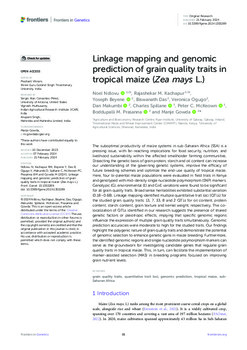Linkage mapping and genomic prediction of grain quality traits in tropical maize (Zea mays L.)
Abstract
The suboptimal productivity of maize systems in sub-Saharan Africa (SSA) is a pressing issue, with far-reaching implications for food security, nutrition, and livelihood sustainability within the affected smallholder farming communities. Dissecting the genetic basis of grain protein, starch and oil content can increase our understanding of the governing genetic systems, improve the efficacy of future breeding schemes and optimize the end-use quality of tropical maize. Here, four bi-parental maize populations were evaluated in field trials in Kenya and genotyped with mid-density single nucleotide polymorphism (SNP) markers. Genotypic (G), environmental (E) and GxE variations were found to be significant for all grain quality traits. Broad sense heritabilities exhibited substantial variation (0.18-0.68). Linkage mapping identified multiple quantitative trait loci (QTLs) for the studied grain quality traits: 13, 7, 33, 8 and 2 QTLs for oil content, protein content, starch content, grain texture and kernel weight, respectively. The co-localization of QTLs identified in our research suggests the presence of shared genetic factors or pleiotropic effects, implying that specific genomic regions influence the expression of multiple grain quality traits simultaneously. Genomic prediction accuracies were moderate to high for the studied traits. Our findings highlight the polygenic nature of grain quality traits and demonstrate the potential of genomic selection to enhance genetic gains in maize breeding. Furthermore, the identified genomic regions and single nucleotide polymorphism markers can serve as the groundwork for investigating candidate genes that regulate grain quality traits in tropical maize. This, in turn, can facilitate the implementation of marker-assisted selection (MAS) in breeding programs focused on improving grain nutrient levels.

